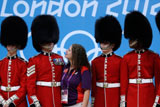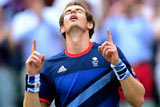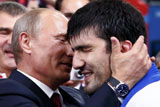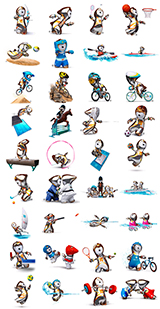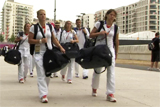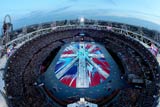Badminton
Updated: 2012-05-14 16:07:25
(london2012.com)
|
|||||||||||
Badminton players at the London 2012 Olympic Games will need lightning-fast reactions if they're to keep up with shuttlecocks travelling at speeds in excess of 400km/h.
During the 19th century, British military officers in the Indian town of Poona added a net to the ancient game of battledore (meaning bat) and shuttlecock, and named this new game after the town.
The sport of Poona was eventually brought back home by the officers, and was played at the Duke of Beaufort's Gloucestershire residence in 1873. The residence was (and is still) called Badminton House, which is how this thrilling sport got the name used today.
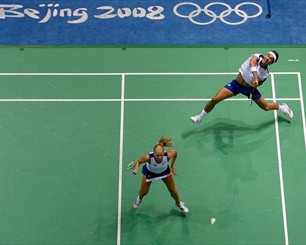 |
Competition dates
July 28 – Aug 5
Competition venue
Wembley Arena
Number of medal events
Five: men's Singles, women's Singles, men's Doubles, women's Doubles and Mixed Doubles.
Number of competitors
172 (85 men and 85 women), with two tbc by the host country (TeamGB can select one man and one womon, two men, or two women)
Each country is limited to three athletes in each Singles event and two pairs (four athletes) in each Doubles event, dependent on their position in the world ranking list of 3 May 2012 that determines qualification.
Field of play
The Singles court is 13.4m long and 5.18m wide; the Doubles court is 13.4m long and 6.1m wide. The court is divided in half by a 1.55m high net (1.524m high in the centre).
History of Badminton at the Olympic Games
One of the most dynamic Olympic sports, Badminton made its full Olympic debut at Barcelona 1992. Asian countries now dominate: China, Indonesia and South Korea have won 23 of the 24 gold medals awarded since the sport's first appearance at the Games.
The basics
Players hit a shuttlecock over the net into their opponents' half. The aim is to score points by playing the shuttlecock so that it cannot be returned over the net within the boundary lines. Olympic shuttlecocks weigh between 4.74 grams and 5.5g and contain 16 feathers, each plucked from the left wing of a goose. They can travel at speeds in excess of 400km/h.
Matches are played over the best of three games. Each game is won by the first player or doubles pair to reach 21 points by a margin of two clear points. However, if the score reaches 29-29 the winner of the next point wins the game.
During a game when the leading score reaches 11 there is a 60-second interval . When the leading score reaches 11 in the third game, players change ends.
In the Singles game, if the server wins the point he/she continues to serve. If he/she loses the point, serve goes to the opposition. Players serve from alternate sides of the court – the left if their score is even, the right if it is odd.
In the Doubles game, one player serves (alternating from the left or right as in the Singles game) until he/she loses a point and the serve goes to the opposition. When serve is regained, the other player on the team becomes the server.
The players who are receiving do not swap sides on each point.
Competition format
There are five medal events: men's Singles, women's Singles, men's Doubles, women's Doubles, and Mixed Doubles. All events begin with a preliminary stage: the competitors are divided into groups and each player or Doubles pair plays everyone else in their group.
The 16 group winners in the Singles and eight best pairs in the Doubles qualify for the knockout stage of the competition, which will eventually decide the winners of the medals.
Officials
An umpire is in charge of the match, ensuring that the rules of the game are observed and calling out the score after each point. He/she is assisted by line judges, who keep an eye on whether the shuttlecock lands in our out of the court.
Keys to success
Badminton is a fast and dynamic sport. Players need to be incredibly fit, have lightning quick reactions and excellent judgment. Doubles players must be in perfect harmony, working together as a team.
Jargon buster
Drive – a fast, low, near-horizontal shot over the net.
Forecourt – the front section of each half of the court, between the net and the short service line.
Lift – a shot played from beneath the height of the net, normally played high to the back of the court.
Smash – a hard overhead shot, hit directly down into the opposition's court.
Medal Count |
||||
| 1 | 46 | 29 | 29 | |
| 2 | 38 | 27 | 22 | |
| 3 | 29 | 17 | 19 | |
| 4 | 24 | 25 | 33 | |
| 5 | 13 | 8 | 7 | |
| 6 | 11 | 19 | 14 | |


